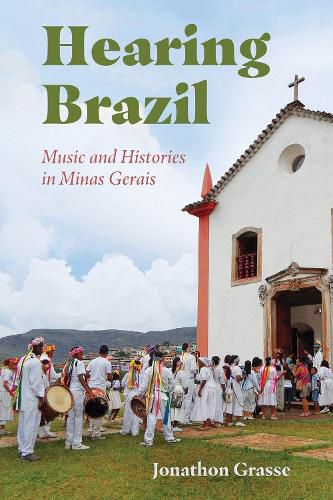Readings Newsletter
Become a Readings Member to make your shopping experience even easier.
Sign in or sign up for free!
You’re not far away from qualifying for FREE standard shipping within Australia
You’ve qualified for FREE standard shipping within Australia
The cart is loading…






This title is printed to order. This book may have been self-published. If so, we cannot guarantee the quality of the content. In the main most books will have gone through the editing process however some may not. We therefore suggest that you be aware of this before ordering this book. If in doubt check either the author or publisher’s details as we are unable to accept any returns unless they are faulty. Please contact us if you have any questions.
Minas Gerais is a state in southeastern Brazil deeply connected to the nation’s slave past and home to many traditions related to the African diaspora. Addressing a wide range of traditions helping to define the region, ethnomusicologist Jonathon Grasse examines the complexity of Minas Gerais by exploring the intersections of its history, music, and culture.
Instruments, genres, social functions, and historical accounts are woven together to form a tapestry revealing a cultural territory’s development. The deep pool of Brazilian scholarship referenced in the book, with original translations by the author, cites over two hundred Portuguese-language publications focusing on Minas Gerais. This research was augmented by fieldwork, observations, and interviews completed over a twenty-five-year period and includes original photographs, many taken by the author.
Hearing Brazil: Music and Histories in Minas Gerais surveys the colonial past, the vast hinterland countryside, and the modern, twenty-first-century state capital of Belo Horizonte, the metropolitan region of which is today home to over six million. Diverse legacies are examined, including an Afro-Brazilian heritage, eighteenth- and nineteenth-century liturgical music of the region’s Minas Baroque, the instrument known as the viola, a musical profile of Belo Horizonte, and a study of the regionalist themes developed by the popular music collective the Clube da Esquina (Corner Club) led by Milton Nascimento with roots in the 1960s. Hearing Brazil champions the notion that Brazil’s unique role in the world is further illustrated by regionalist studies presenting details of musical culture.
$9.00 standard shipping within Australia
FREE standard shipping within Australia for orders over $100.00
Express & International shipping calculated at checkout
This title is printed to order. This book may have been self-published. If so, we cannot guarantee the quality of the content. In the main most books will have gone through the editing process however some may not. We therefore suggest that you be aware of this before ordering this book. If in doubt check either the author or publisher’s details as we are unable to accept any returns unless they are faulty. Please contact us if you have any questions.
Minas Gerais is a state in southeastern Brazil deeply connected to the nation’s slave past and home to many traditions related to the African diaspora. Addressing a wide range of traditions helping to define the region, ethnomusicologist Jonathon Grasse examines the complexity of Minas Gerais by exploring the intersections of its history, music, and culture.
Instruments, genres, social functions, and historical accounts are woven together to form a tapestry revealing a cultural territory’s development. The deep pool of Brazilian scholarship referenced in the book, with original translations by the author, cites over two hundred Portuguese-language publications focusing on Minas Gerais. This research was augmented by fieldwork, observations, and interviews completed over a twenty-five-year period and includes original photographs, many taken by the author.
Hearing Brazil: Music and Histories in Minas Gerais surveys the colonial past, the vast hinterland countryside, and the modern, twenty-first-century state capital of Belo Horizonte, the metropolitan region of which is today home to over six million. Diverse legacies are examined, including an Afro-Brazilian heritage, eighteenth- and nineteenth-century liturgical music of the region’s Minas Baroque, the instrument known as the viola, a musical profile of Belo Horizonte, and a study of the regionalist themes developed by the popular music collective the Clube da Esquina (Corner Club) led by Milton Nascimento with roots in the 1960s. Hearing Brazil champions the notion that Brazil’s unique role in the world is further illustrated by regionalist studies presenting details of musical culture.